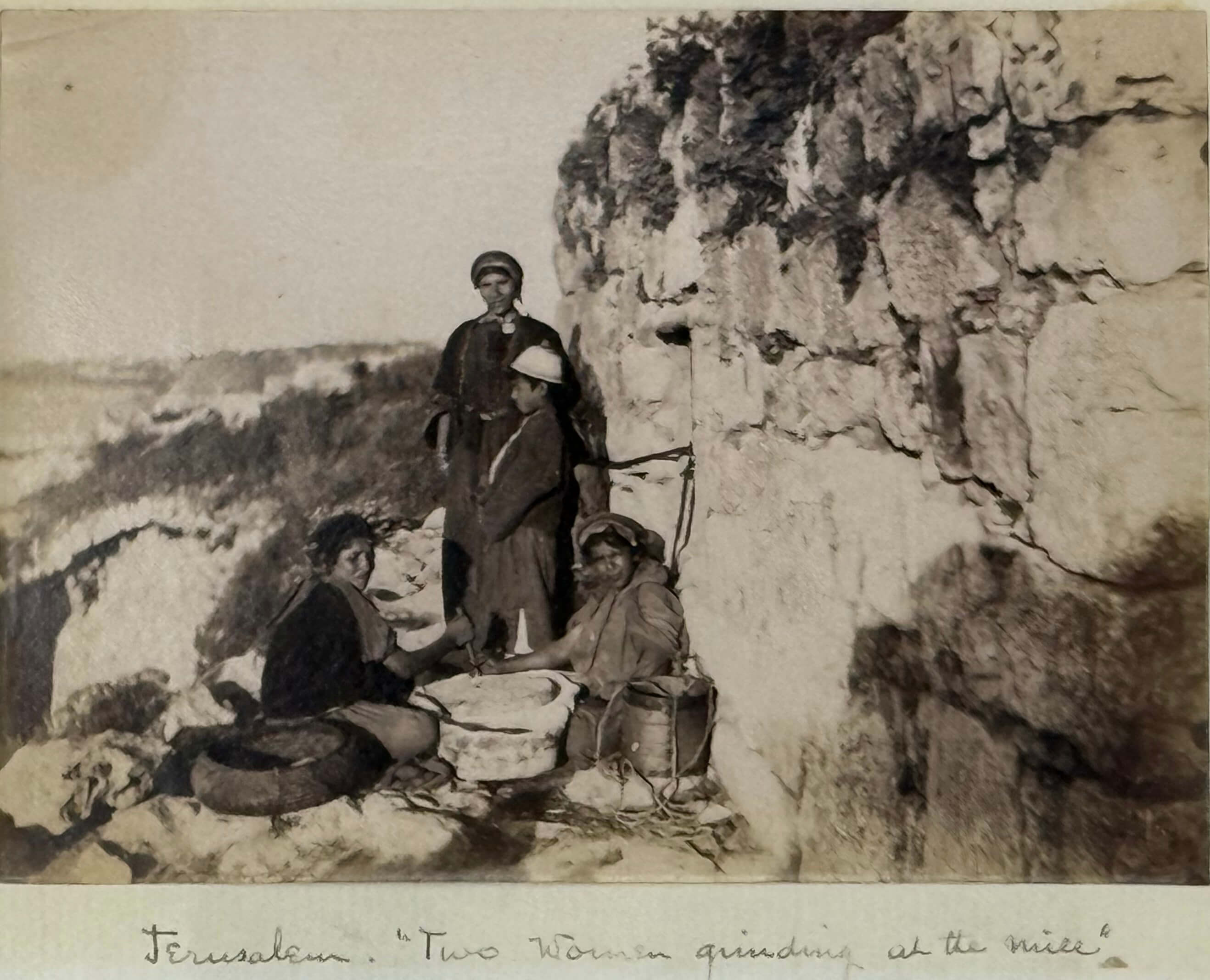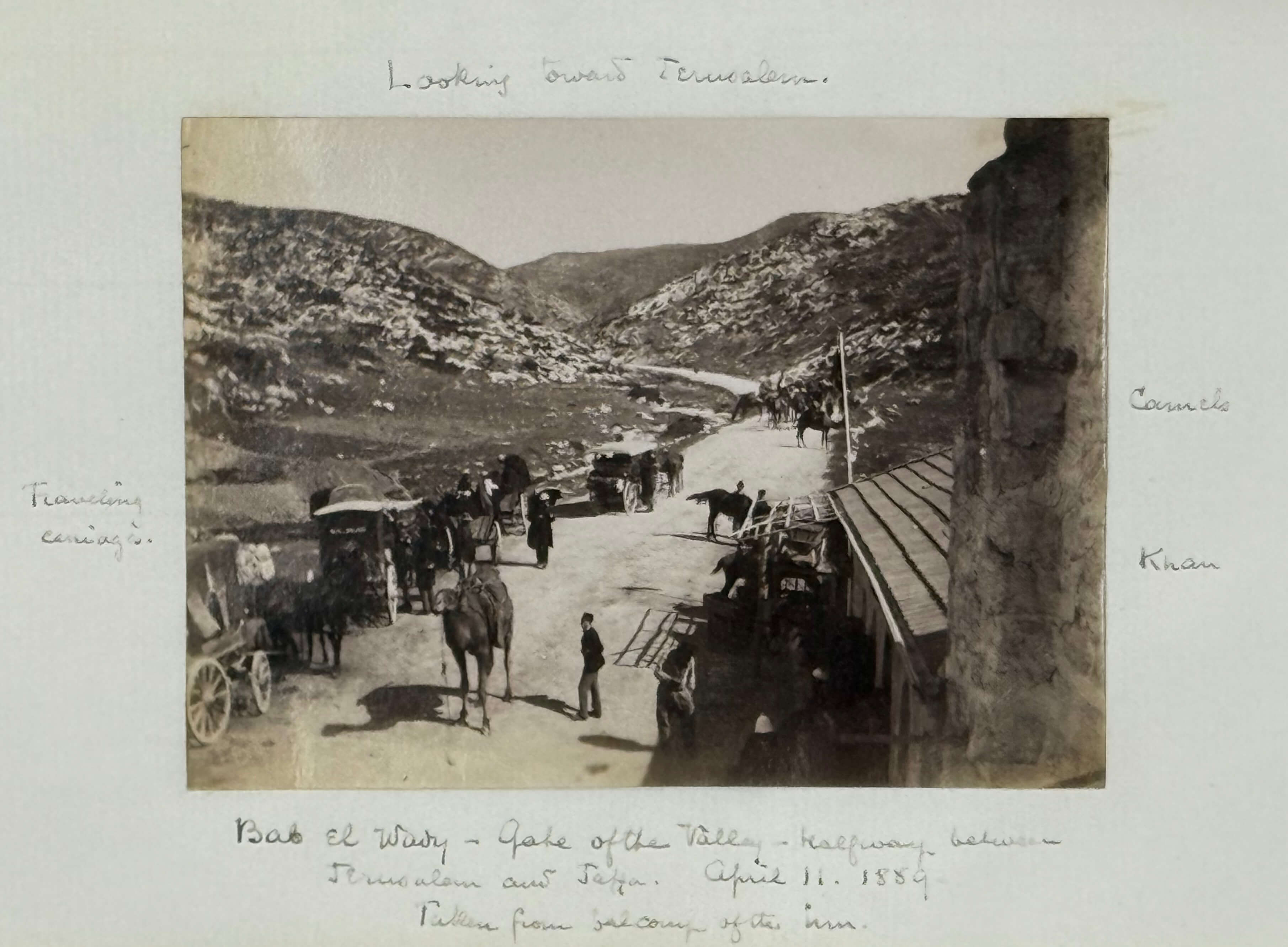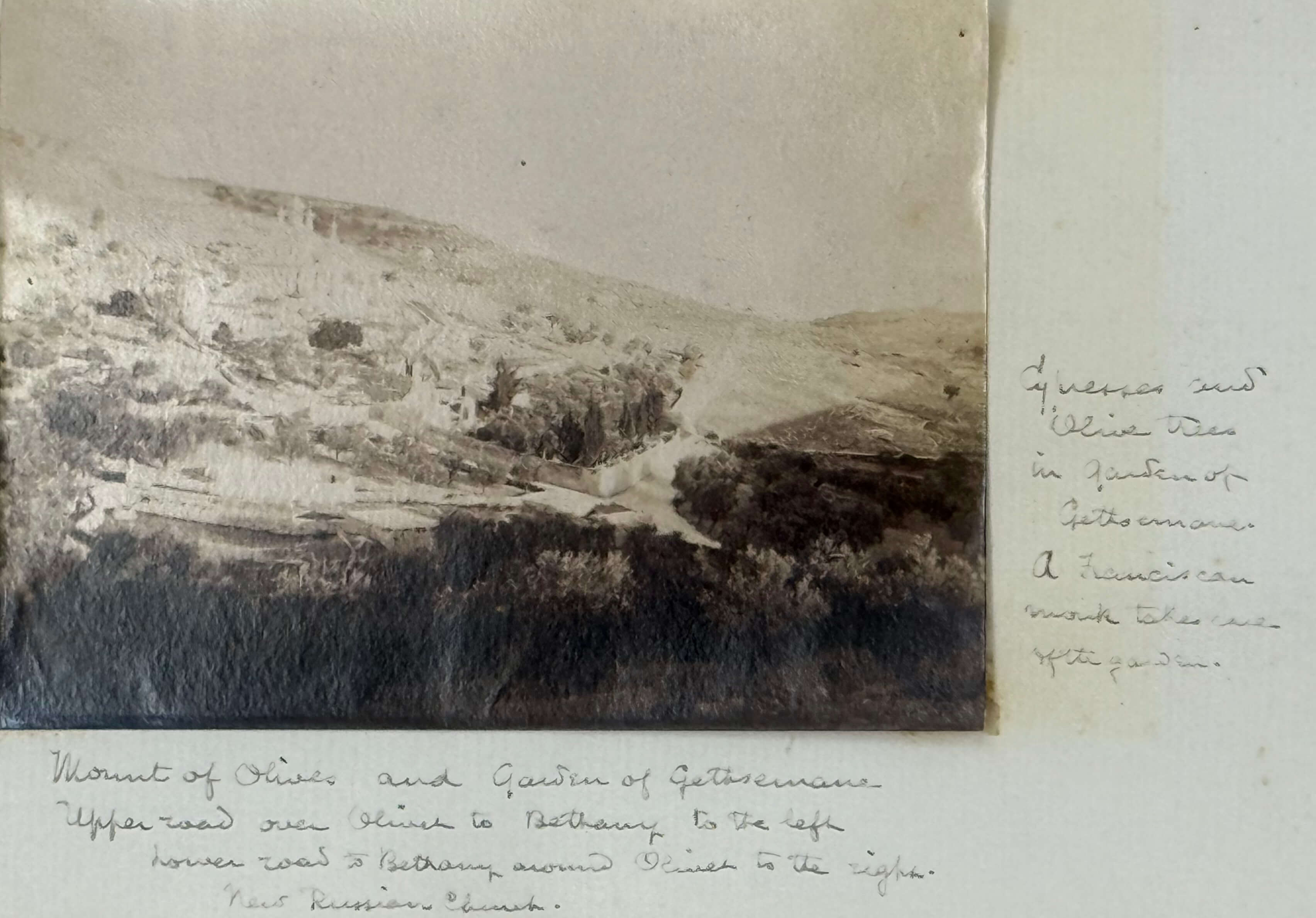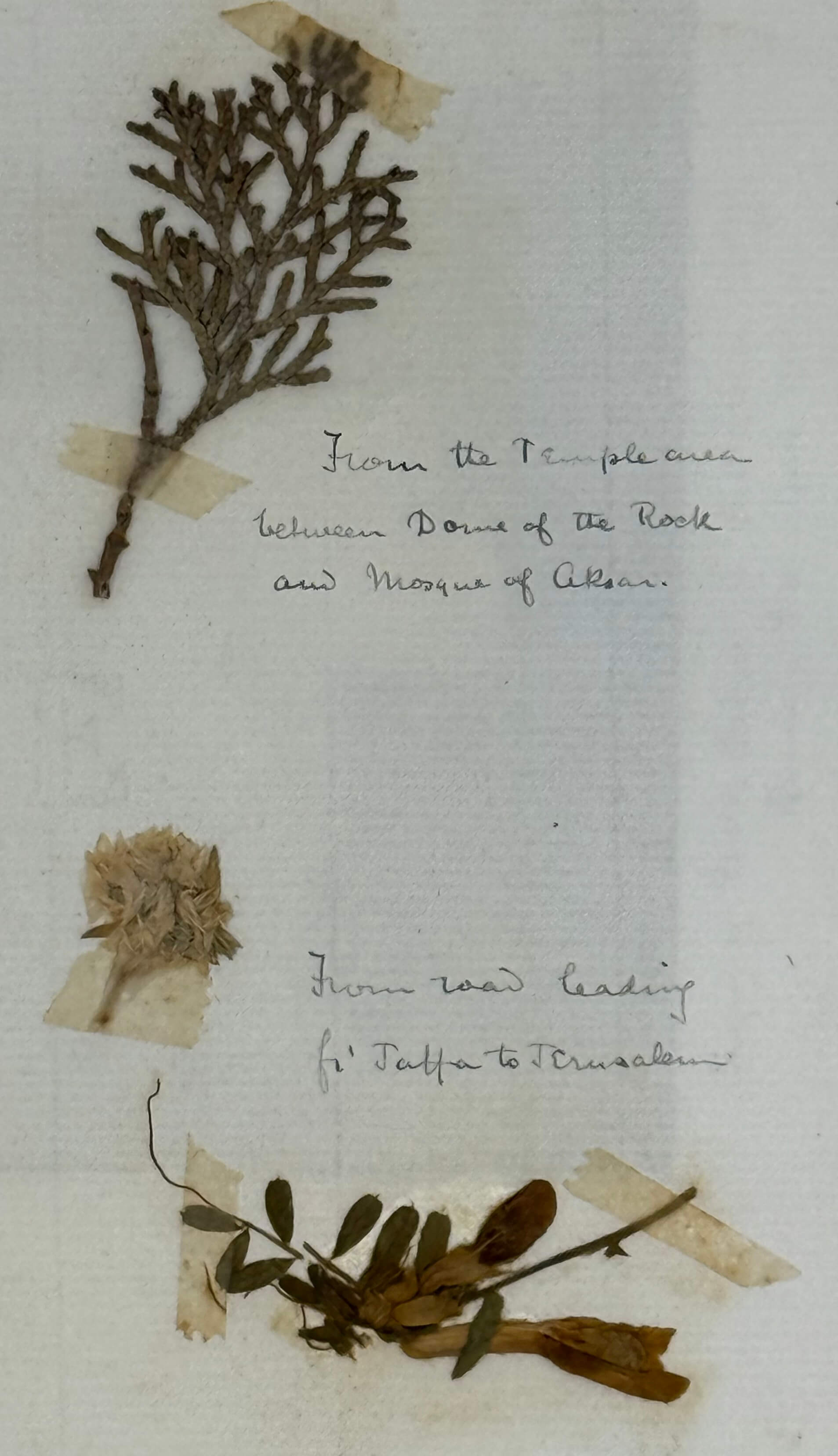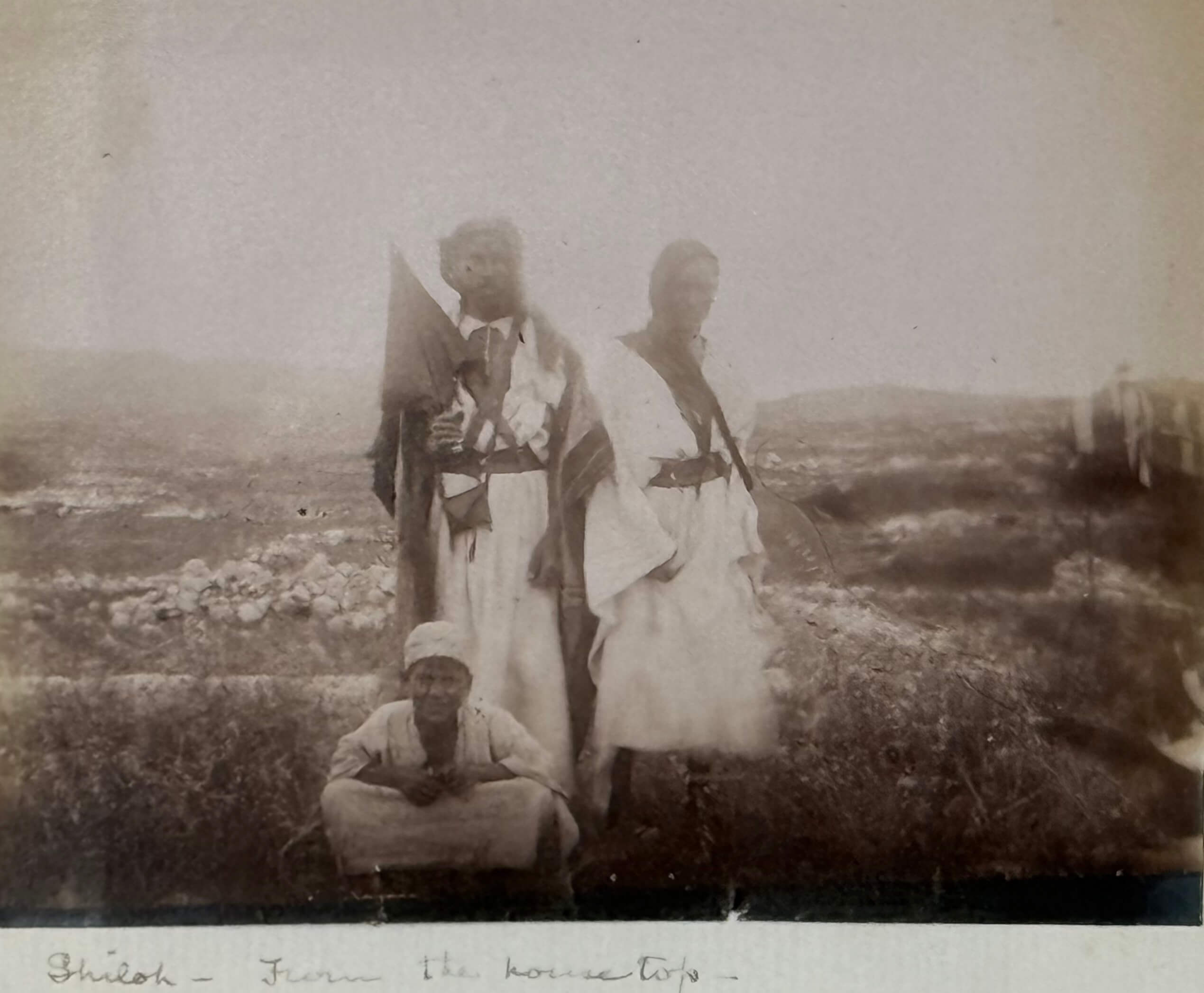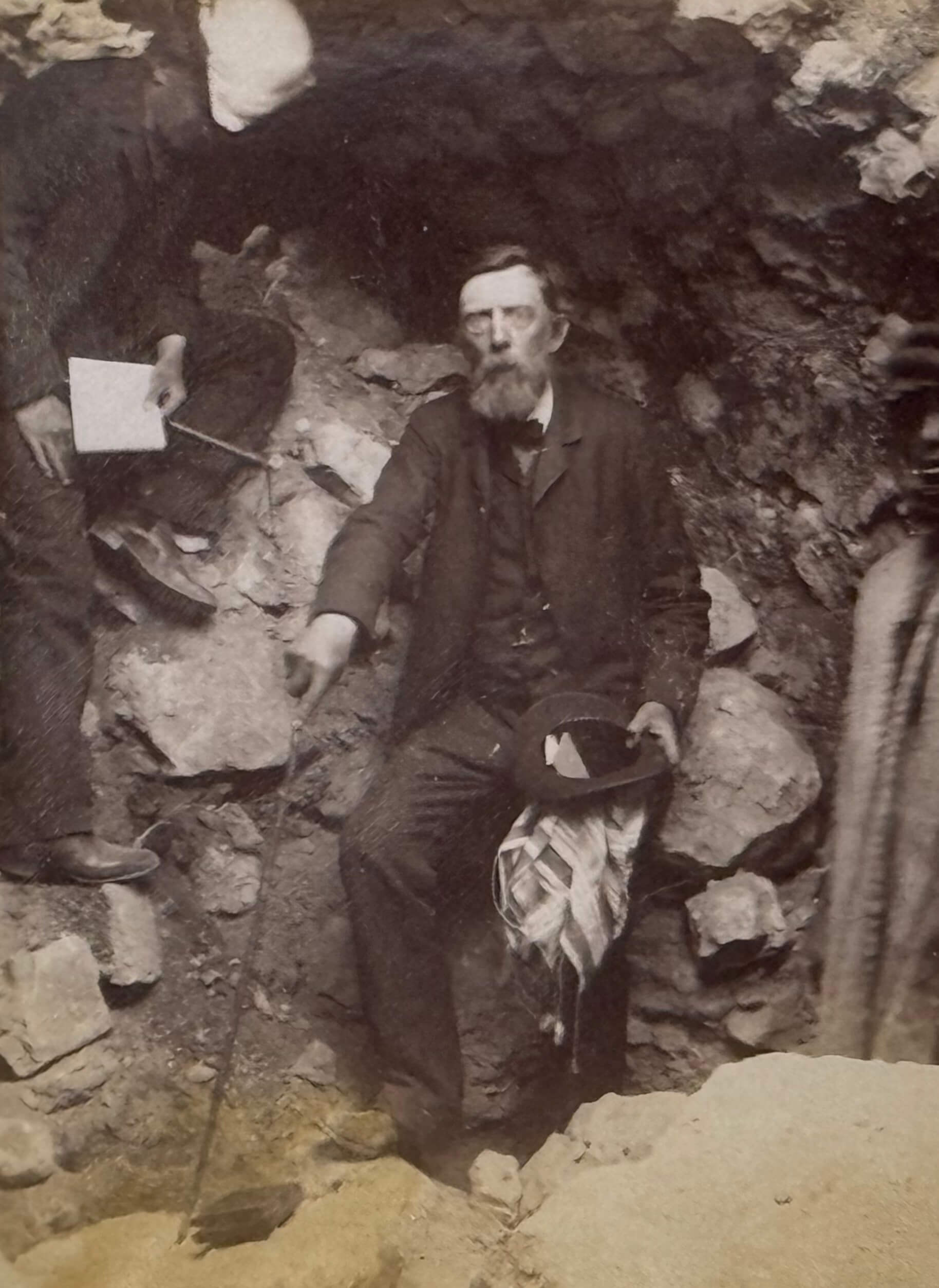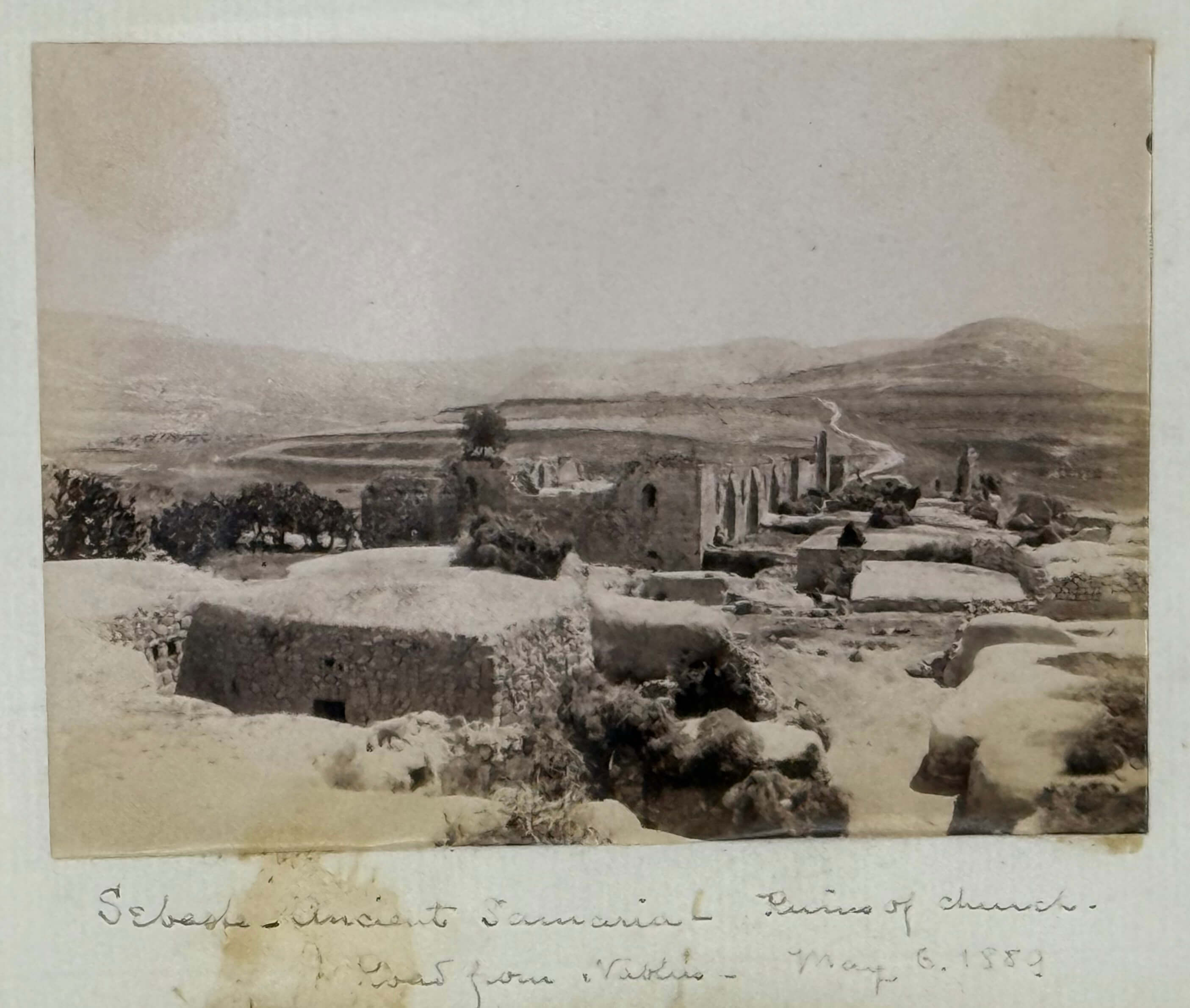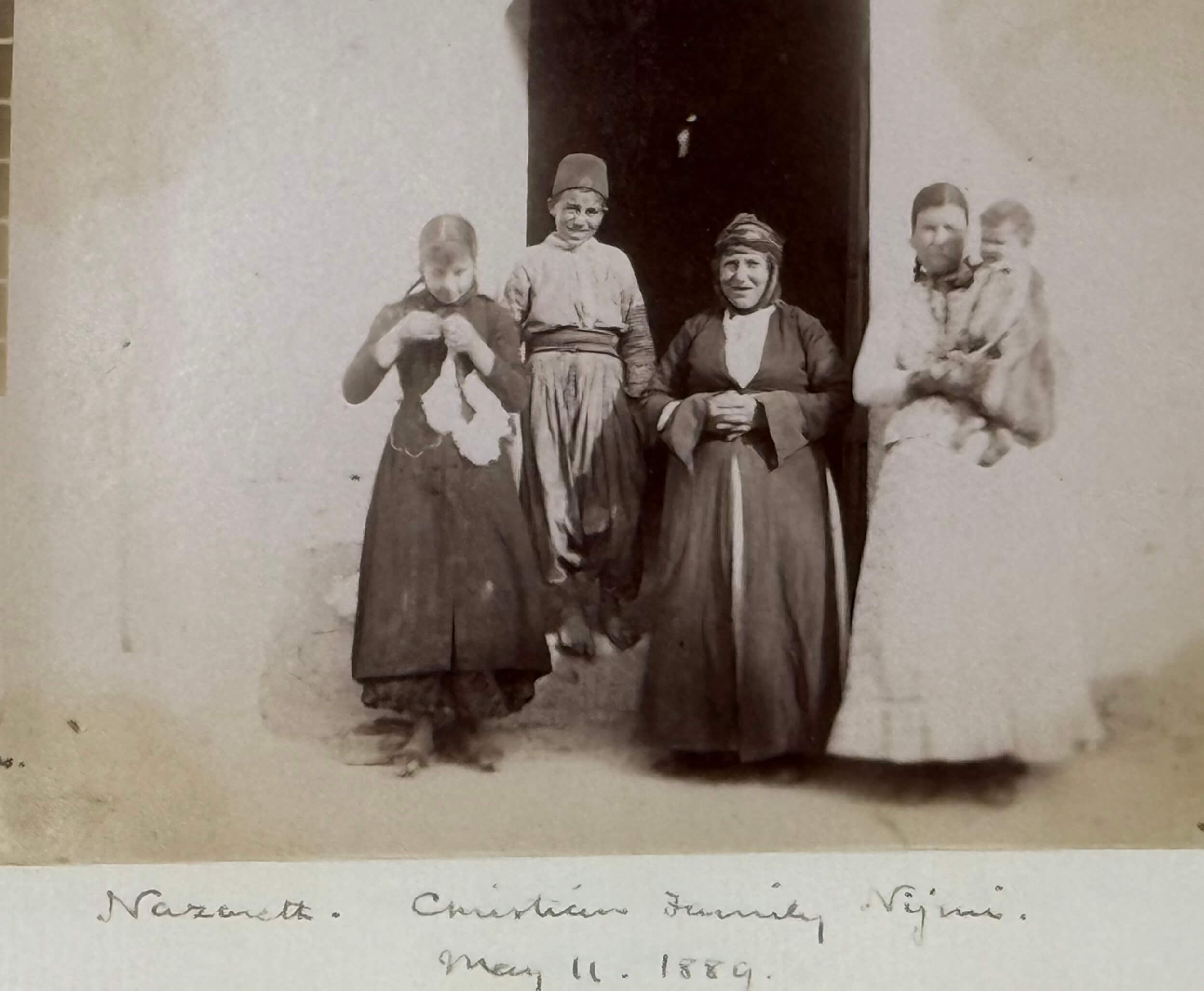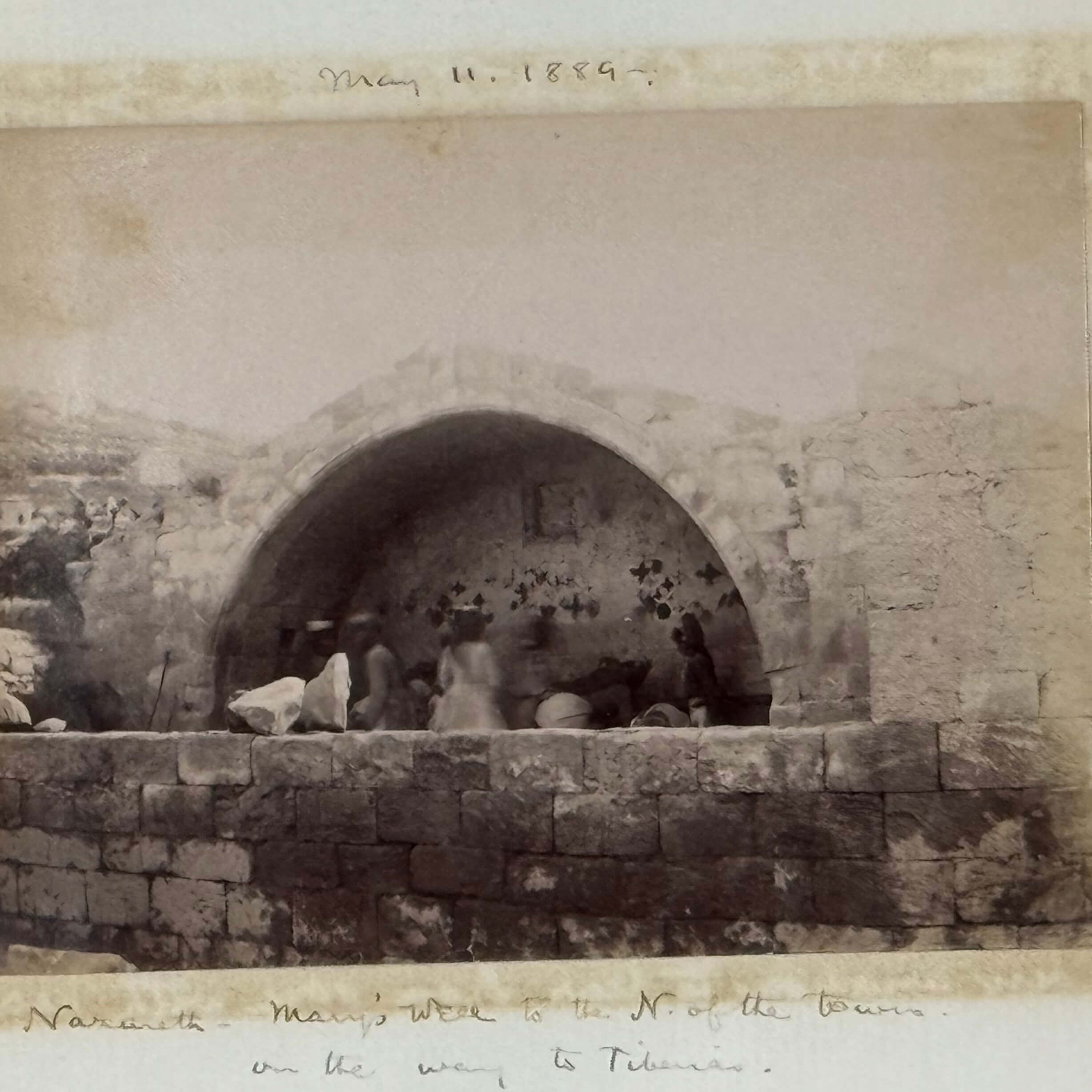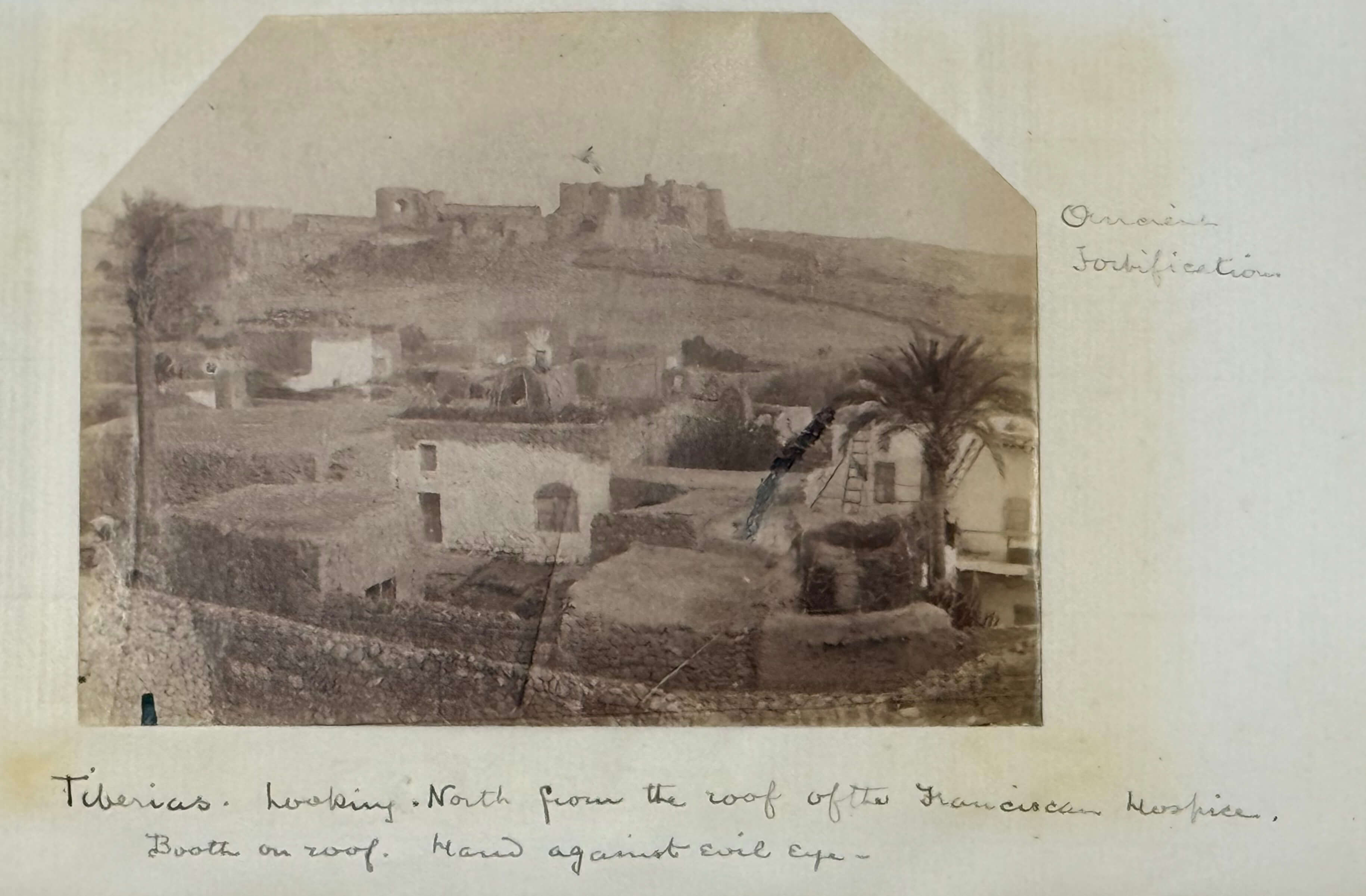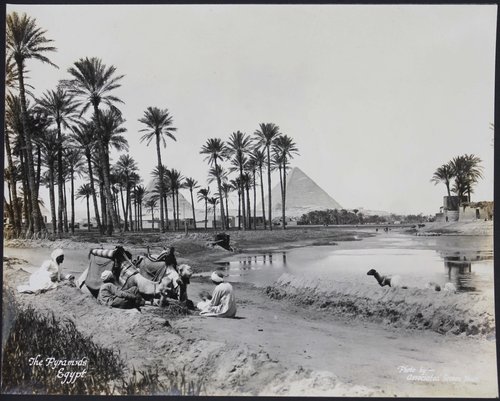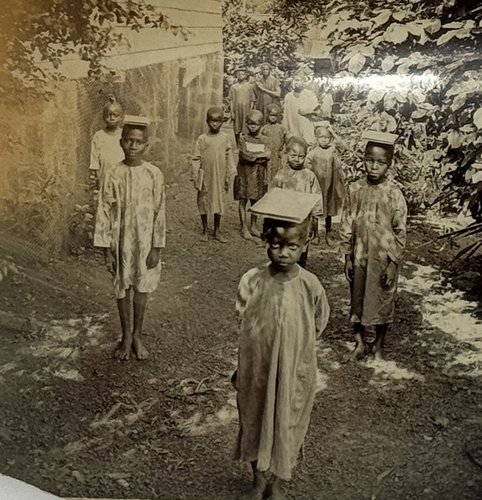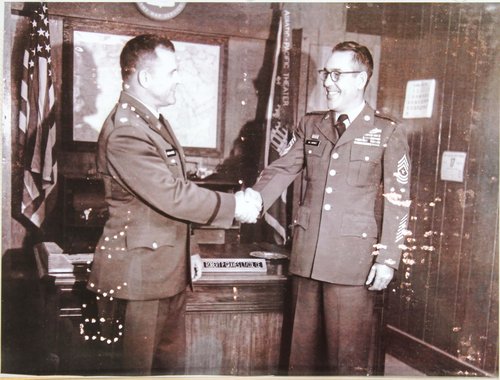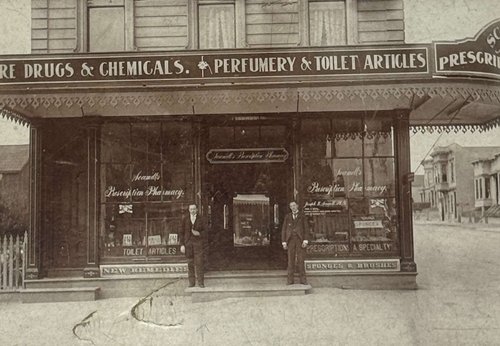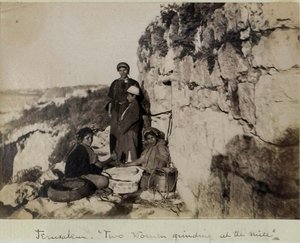
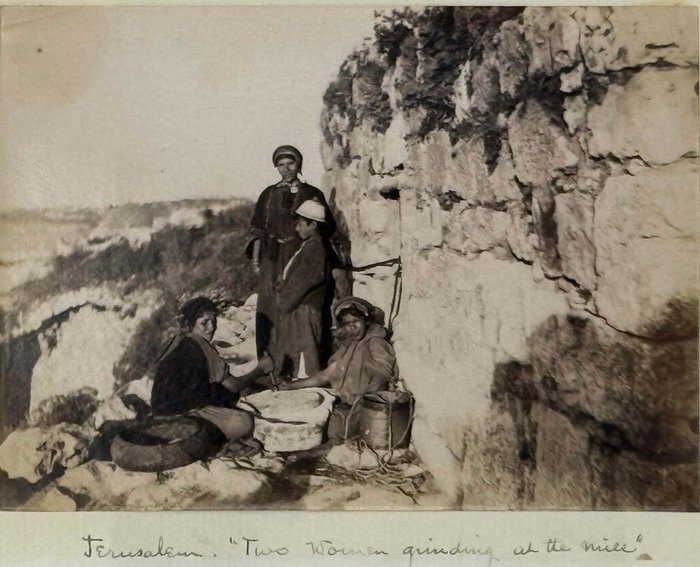

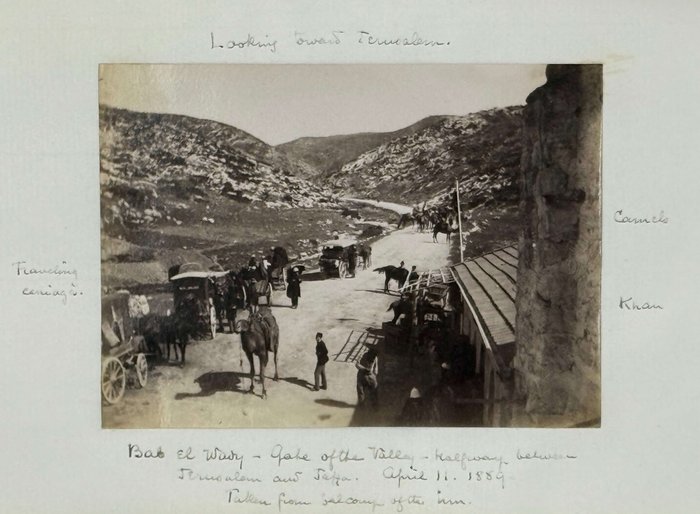
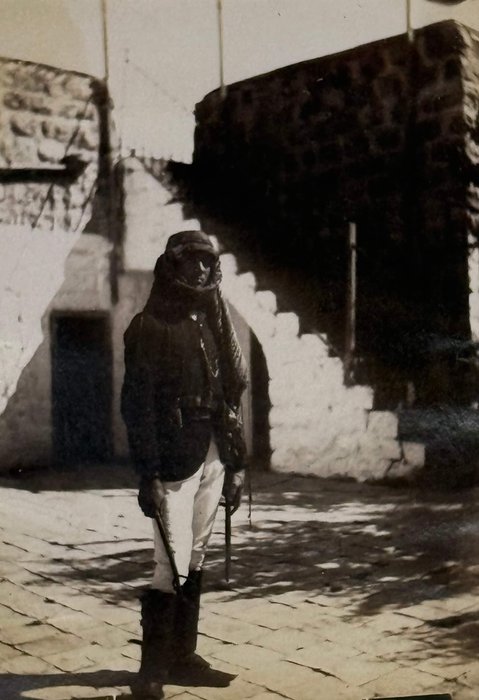
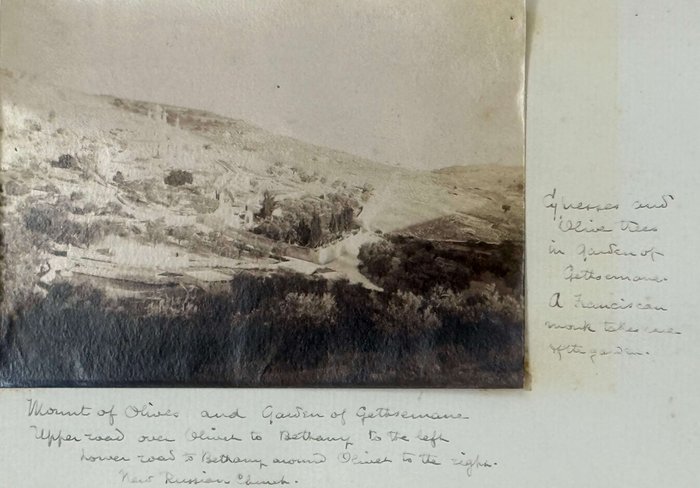
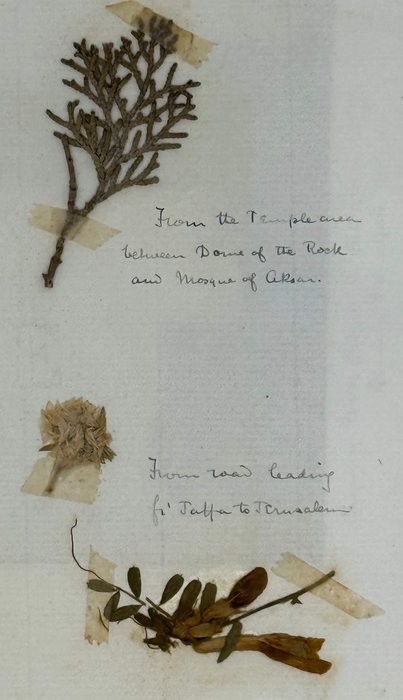

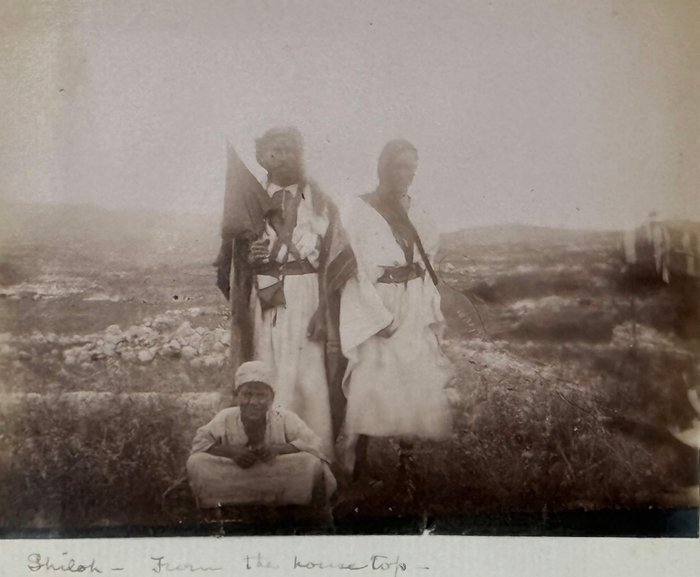
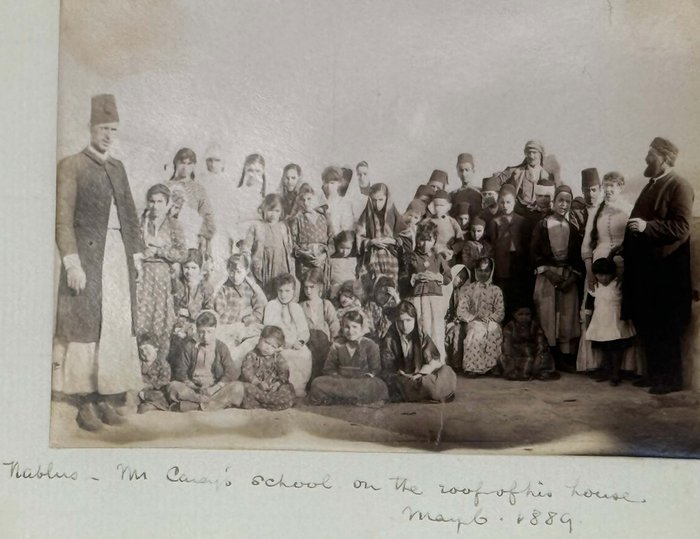
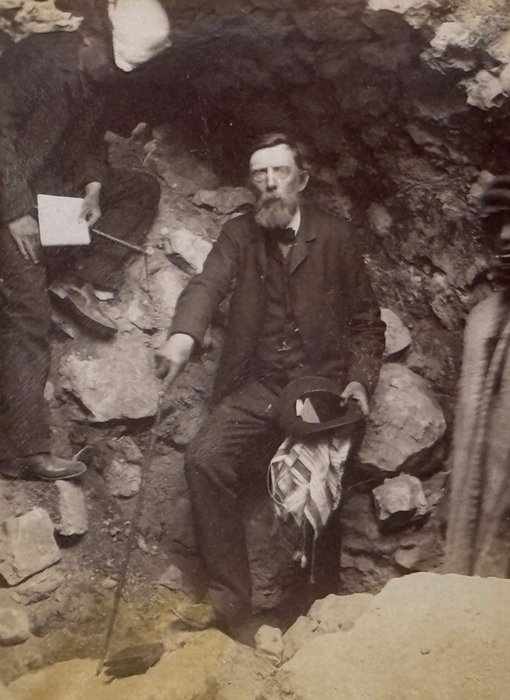

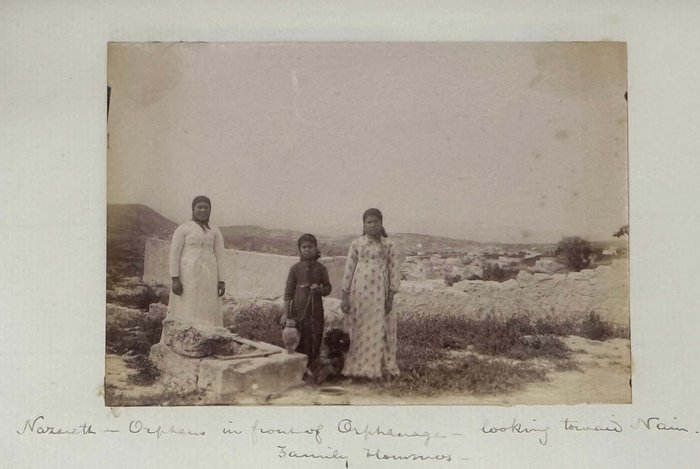
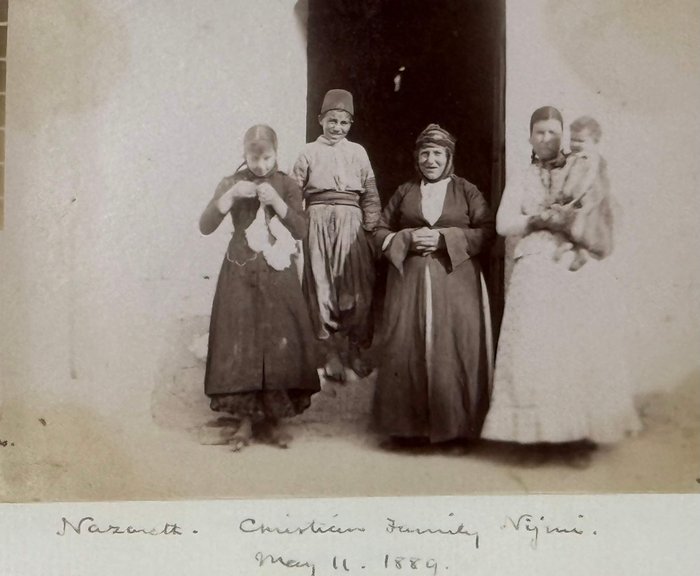
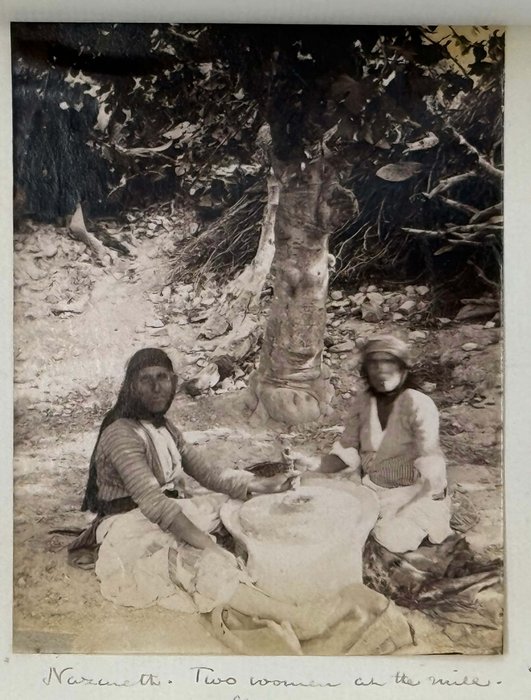
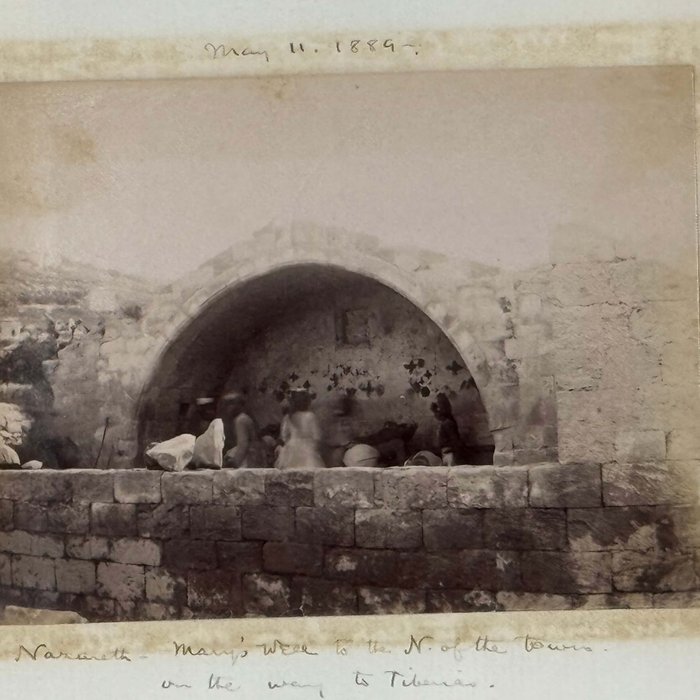
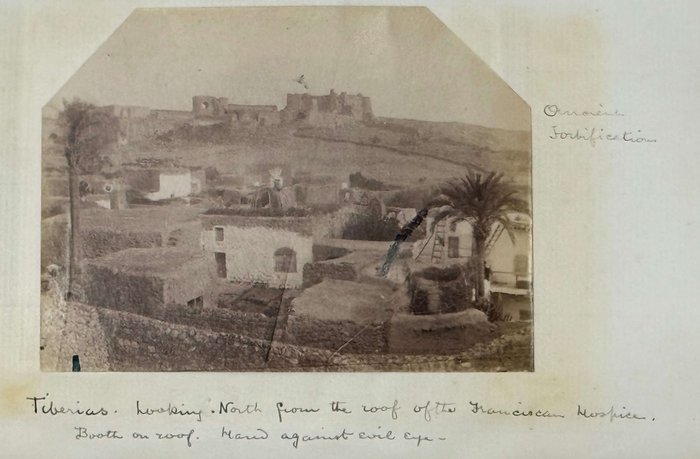
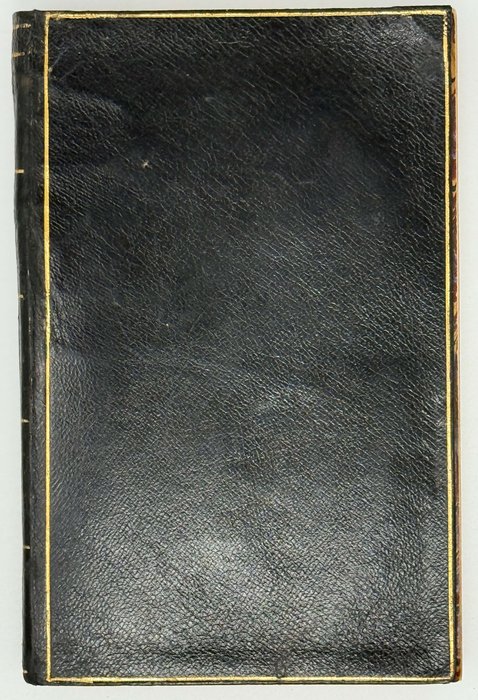
#PD55
Ca. 1889
Small Octavo (ca. 19,5x12,5 cm or 7 ¾ x 4 ¾ in). 67 watermarked creamy laid paper leaves (8 blank). With 59 mounted original abumen photos from ca. 8x11 cm (3 x 4 ¼ in) to ca. 4x10,5 cm (1 ½ x 4 in). All photos with period manuscript ink captions by McCrackan on the mounts; most photos are also with manuscript ink dates from March to August 1889; ca. eight photos are also captioned in negative. With eight mounted period printed postcards with the views of the Holy Land and one loosely inserted printed postcard, filled in by McCrackan from the “Prussian Hospice, Jerusalem” and sent to “Misses McCrackan, Firenze, Italia.” With over a dozen dried specimens of flowers and leaves of the Palestinian plants, mounted on the leaves, a loosely inserted keepsake card, or pieces of card in the envelope, mounted on the last leaf. Period presentation inscription on the first leaf: “To my dear Aunts from John. June 16, 1889.” Period black full sheep journal with decorative gilt-lettered borders on both boards and the spine; decorative endpapers; all edges coloured. One photo with a crease, a couple of photos mildly faded, but overall a very good journal with interesting strong photos.
Historically significant original journal with 59 rare albumen snapshot photographs, supplemented with detailed manuscript captions, printed postcards and dried plant specimens, which comprise the account of an 1889 trip to the Holy Land by two American clergymen. The journal was compiled by John Henry McCrackan, a member of the Episcopal Church in the United States, who then served as an assistant at the Christ Church Cathedral in Hartford, Connecticut. According to the inscription on the first leaf, it was most likely presented to McCrackan’s wife, Cora Gertrude Bailey (1862-1924).
The photographs and accompanying materials cover the period from March to August 1889, including McCrackan’s travel to Palestine on April 10 – May 16. He left Naples on April 3, arrived in Jaffa a week later and stayed in Jerusalem for two weeks, celebrating Easter (April 21) and visiting Bethany and the Mount of Olives. On May 3 – 16, McCrackan travelled to Nazareth and the Sea of Galilee and back via Mount Carmel and Haifa. During that journey, he was accompanied by a noted Moravian pastor and future bishop of the Salem Moravian Congregation (since 1891), Edward Rondthaler, who visited the Holy Land with his son, Howard Edward Rondthaler (1871-1956).
Over a dozen images show Jerusalem, its environs and inhabitants: “Bab el Wady - Gate of the Valley - halfway between Jaffa and Jerusalem,” the interior of the Anglican Christ Church during the “Holy Week and Easter Day,” the Mount of Olives and the Garden of Gethsemane, general views of Jerusalem taken from the upper and lower road to Bethany, Bethany (general view, the house of Martha and Mary, the tomb of Lazarus) and the interior of “chapel of pastor Schnaller, Bethlehem.” There are also portraits of “Herr Kaminitz and family” (the owner of Hotel Jerusalem), a young waiter in the same hotel, “Bayer and family” (the owner of the Prussian Hospice in Jerusalem), and “two women grinding at the mill, Jerusalem” (an illustration to the words of Jesus from the Gospel of Matthew).
Over thirty photos illustrate the trip to Nazareth and the Sea of Galilee and show biblical Shiloh and the site of Jacob’s Well near Nablus (both in modern-day West Bank), Rev. Edward Rondthaler posing inside the Jacob’s Well, a Nablus missionary “Mr. Carey” (posing with his family, inside the church and with his parish), the ruins of Samaria (Sebastia, West Bank), the spring at Sileh et Dahr north of Samaria, and Jezreel and Shunem (Yizre’ela and Sulam, both in north-eastern Israel). The other photos were taken in famous towns and villages, related to Jesus’s ministry around the Sea of Galilee and show Keffr-Kenna (biblical Cana), “Kurun Hattin, Horns of Hattin, called the Mount of the Beatitudes” (Lower Galilee), “Jordan entering the Sea of Galilee,” Capernaum (the ancient slab from Tell Hum), Bethsaida (the travellers’ boat and local crew, pioneers of the “German colony, three months old”), “beduin tent near Kefr Kenna”, Tiberias (“looking north from the roof of the Franciscan hospice”), and Nazareth (Mary’s Well, a Christian family, “two women grinding at the mill,” and “orphans in front of Orphanage”). One photo portrays Rondthaler, his son and guides during a “halt for water between Kefr Kenna and Tiberias.” The journal also includes a group portrait of female students and teachers from “Miss Arnot’s [Tabeefa] School” in Jaffa. Tabeefa School was founded in 1863 by Jane Walker-Arnott under the auspices of the Church of Scotland and continues to work today as a co-educational school.
The photos from the Palestine trip end with two images taken on board the steamer “Asia” “of the Florio-Rubattino Line,” which took McCrackan back to Italy from Alexandria. The journal also includes nine photos taken in Rome and Capri in March 1889, showing the Appian Way, the harbour of Capri, the interior of the “Cave of Mithras” and portraits of McCrackan, his wife Cora Gertrude Bailey (1862-1924) and their three-year-old daughter Gertrude. Two images at the rear depict passengers on board the “steamship Rhineland, Aug. 17, 1889.”
Eight mounted printed postcards show Jerusalem (Tombs of the Kings, Esse Homo Arch, Grotto of Jeremiah), Capernaum, Magdala, Tiberias, Nein, and a Beduin tent. The loosely inserted postcard of “Union Postale Universelle Turquie” was sent from the Prussian hospice in Jerusalem to McCrackan’s wife in Florence and contains the account of his latest encounters in the city. Among the dried specimens are the plants taken “from the Temple area between Dome of the Rock and Mosque of Aksa,” “from field of the Shepherd near Bethlehem,” “Temple wall,” “road between Jaffa and Jerusalem,” “Dead Sea,” “picked for you, Palm Sunday 1889, between Bethany and Jerusalem where the City first appears,” &c.
Overall a historically significant, content-rich original source on the history of American pilgrimages to Palestine in the 19th century.
“The Rev. John H. McCrackan was born in New York in 1856 and was educated in Europe. On his return to this country, he entered Trinity College and was graduated in 1882. His first call was to Christ Church, in Hartford. He was assistant to the Rev. William F. Nicholas, now Bishop of California. His health failing, he made a trip to Europe, and later to California. He had a charge in Rome, and three years ago became Chaplain of the [American Church of the Ascension] in Munich” (Death list of a Day// The New York Times. 24 July 1906, p. 7).
Edward Rondthaler, “Moravian bishop, pastor, administrator, teacher, historian, editor, writer, linguist, and community leader, was born at Schoeneck, Northampton County, Pa., in the parsonage of Schoeneck Moravian Church, which his father, Edward Rondthaler, Sr., served as pastor from 1841 to 1844.” He graduated from the Moravian Theological Seminary (Bethlehem, Pa.) and later the University of Erlangen, Germany. In 1877, he became pastor of the Salem Moravian congregation (North Carolina) and remained there until the end of his life, serving in various capacities, including the principal of Salem Female Academy, member and president of the Provincial Elders’ Conference, a member of the Moravian College and Theological Seminary Board of Trustees, Chairman of the Salem Boys' School Board of Directors, &c. He became a bishop of the Moravian church in the United States in 1891. In 1930, the Winston-Salem Chamber of Commerce named Rondthaler the city's Outstanding Citizen and awarded him its Service Cup for "meritorious, unselfish and distinguished community service." (see more: Dictionary of North Carolina biography).

